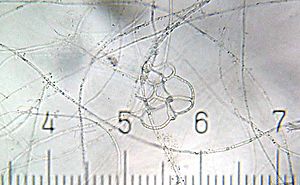Carnivorous fungus facts for kids
Carnivorous fungi are special types of fungi. Unlike most fungi that get food from dead plants, these fungi catch and eat tiny animals. They get some of their important nutrients from these small creatures. More than 200 different kinds of carnivorous fungi are known to exist.
Contents
What are Carnivorous Fungi?
Carnivorous fungi are unique fungi that get some of their food by trapping and digesting small animals. These animals are often so tiny you need a microscope to see them. A common target for these fungi are nematodes, which are also called roundworms. There are over 200 known types of these amazing fungi.
How Do They Trap Animals?
Carnivorous fungi use different clever ways to catch their prey. Scientists have found two main types of traps they use, especially when hunting nematodes. These traps can be active, meaning they move, or passive, meaning they wait for the prey.
Active Traps: Constricting Rings
Some carnivorous fungi use active traps called constricting rings. Imagine a tiny lasso that tightens very quickly. When a nematode or other small animal wiggles through one of these rings, the ring suddenly swells up and squeezes the animal. This traps the prey firmly. It's a very fast and effective way to catch a meal.
Passive Traps: Adhesive Structures
Other carnivorous fungi use passive traps. These traps don't move. Instead, they have sticky parts that act like glue. These sticky parts can be:
- Adhesive knobs: These are small, sticky bumps on the fungus.
- Adhesive nets: These are sticky webs or networks of fungal threads.
- Adhesive columns: These are sticky stalks or pillars.
- Non-constricting rings: These rings are also sticky, but they don't tighten.
When a small animal touches these sticky structures, it gets stuck. The fungus then grows into the trapped animal and slowly digests it to get nutrients.
See also
 In Spanish: Hongo carnívoro para niños
In Spanish: Hongo carnívoro para niños


